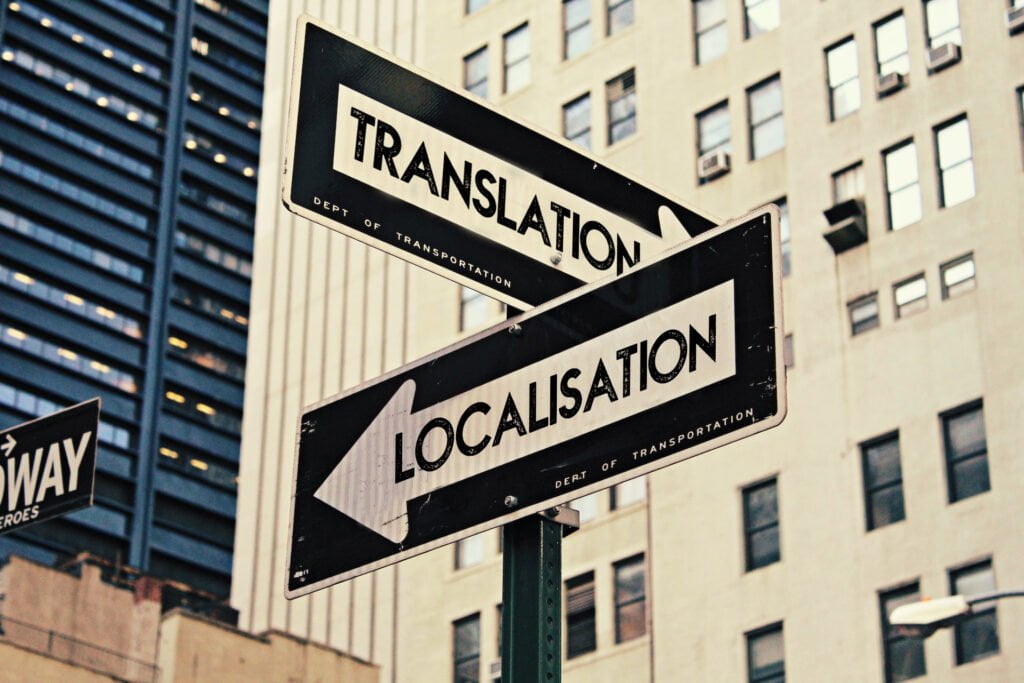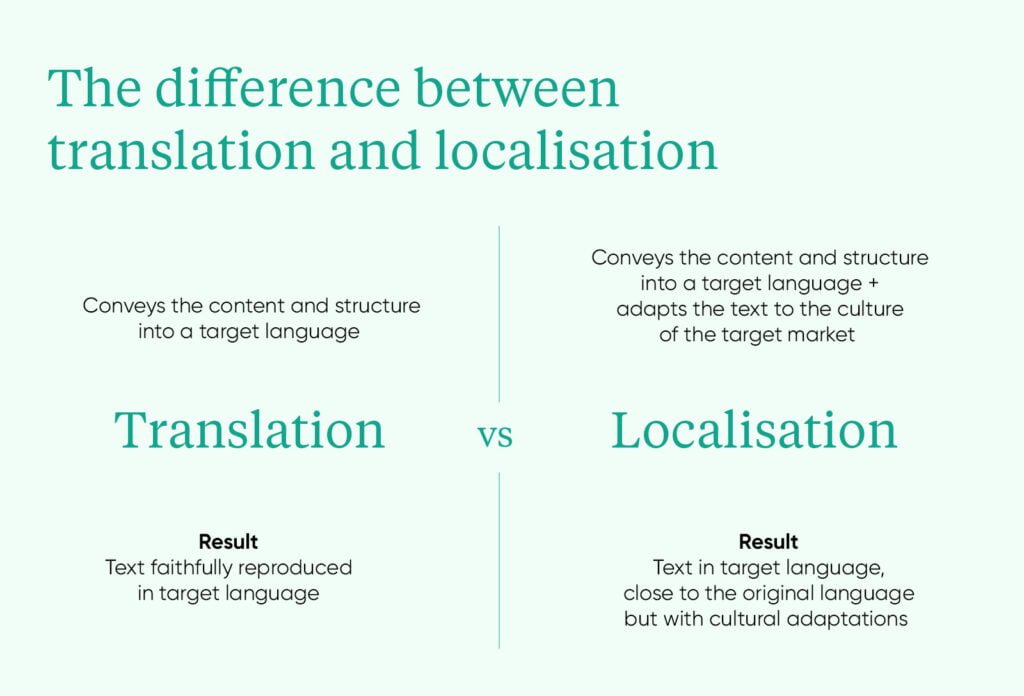Translation vs localisation: The key differences
Instead of conventional translations, a growing number of agencies are opting to offer localisations tailored to specific text types. But was exactly is the difference between a translation and a localisation? And in what cases is one better suited than the other? We set out everything you need to know in this article.

- Definition:What is a translation?
- Which text types are suitable for translation?
- What is localisation?
- When do I need a localisation and why?
- Examples of localised content
- Is there another step beyond localisation?
- What are the challenges involved in localisation?
- Summary: Localisation is becoming increasingly important
Professional translation is a complex task: it often includes far more than simply converting content from one language into another. For texts to sound authentic in the target language and land correctly in the target country, a translator must consider the cultural and thematic context, text type and target audience in their work.
In short
- While translation and localisation are frequently used synonymously, this creates false expectations.
- Localisation is an augmented form of translation and also tailors the text to the culture of the target market.
- Localisation is relevant in particular for strategic content, including website copy, app content and marketing materials.
Definition: What is a translation?
A translation converts the content and structure of a document as faithfully as possible from one language into another language. The aim of a good translation is for the translated text to read completely naturally, as if it were the original text and not a translation. This is why translations should always be carried out by native speakers of the target language. They are in the best position to meet the need for natural language and authenticity.
Which text types are suitable for translation?
Translation is the right choice for:
- Product descriptions
- Contracts
- Technical data sheets
- GTCs
- Privacy policies
A translation is always the best solution in cases where the content in the source text needs to be reproduced as precisely as possible in the target language. The structure of the text also remains unchanged for the same reason. Faithful translation is particularly important when it comes to scientific, technical or legal texts with specialist terminology.
What is localisation?
In the case of localisation (sometimes also referred to using the abbreviation L10n – with the 10 representing the letters between the L and n), the aim is not only to convert the source text into the target language but also to tailor the text to the cultural characteristics of the target market, adapting the text as required to ensure its meaning is fully understood. In this sense, localisation goes one step further than conventional translation. Ultimately, it aims to tailor the target language content and its tonality to the target market – including in cases where the target market is entirely different to the market for which the text was originally written. Although a localisation still takes its lead from the content and structure of the original text, it is adapted to the target audience so that it appears entirely idiomatic – as if it was written specifically for that market.
The difference between localisation and translation
Translation and localisation are often used synonymously, which can create confusion and create false expectations. In fact, localisation builds on translation. In a translation, the translator accurately and faithfully converts the original text into the desired target language.
The content remains unchanged. In a localisation, however, a certain degree of adaptation may be required, including changes to the content, in order to adapt the source text to the target market. You could also call the two methods basic translation and localised translation – because both types convert content into another language, just with different degrees of adaptation.
”Localisation is augmented translation: it also involves adapting source texts to the culture of the target market.”

When do I need a localisation and why?
Localisation is the right choice for:
- Websites
- Apps
- Catalogues
- Presentations
- Press materials
- Blog posts
- Landing pages
- White papers
- Marketing materials

Whether localisation is the right choice for your company depends in large part on your aims and the source texts you have. Localisation is a sensible choice for website copy, app content and marketing materials. It is a strategic, market-specific approach to content translation and allows you to use your content to pursue often very local goals.
Website localisation
Nowadays, a professional, attractive website is an essential part of a company’s basic setup. If you want to tap into new markets with your products and services, it’s vital that you present your offer in the relevant languages. It’s particularly important to do so with an authentic, local voice so that users don’t immediately notice that you’re an international provider. Adapting to standard local practices – such as using common units, currency, date and time formats and telephone number formats – can help to create this impression.
TIP
Search volumes and search behaviour vary significantly from country to country. So, in addition to localising your content, it is also important to localise your SEO strategy and used localised keywords.
Website localisation
Put your customers at ease right away: We offer website and blog localisation in more than 30 languages.

App localisation
Apps work best when they are precisely tailored to the target audience and target market. This applies to the text content in the app but also the design, icons, keywords, imagery, functions and many other factors.
With this in mind, the best approach is to conduct a comprehensive analysis of the target market and market potential before starting the localisation.
Marketing localisation
In a localisation project, the commercial context is obviously important – but so too are the social and cultural contexts. When it comes to translating your advertising materials and informative literature, it’s important to adapt aspects such as locations, shipping costs and other local specificities to the target country.
This means that localisation is the best choice for marketing content, as these texts are hugely heavily geared to a specific target group. Even freer forms of translation can be used for claims and slogans, such as transcreation (see below).
Examples of localised content
A localisation tailors parts of the original text to the target market. For marketing translations into Dutch, for example, you should consider whether you want to use the informal “jij” or the formal “u” to address your audience directly. It doesn’t matter whether you use “tu” or “vous” in French, or “du” or “Sie” in German – you should make this decision solely by looking at your Dutch-speaking target audience. A basic translation will not usually consider adapting this. By contrast, a localised translation will give thought to these cultural specificities. The same goes for a range of other functional and cultural aspects.
Date and time formats
Countries around the world write the date and time in different ways. Does your target market use date-month-year or month-date-year? 24-hour clock or 12-hour clock? And what punctuation do they use in their short date formats? Localisation adapts these aspects to the standard practices in the target country.
Telephone numbers and contact details
A company’s contacts, email addresses and telephone numbers usually differ from market to market. So too does the way these contact details are displayed. For example, some countries have “00” in their international prefix – but not all. The USA and Canada, for example, use “011”. It’s vital that you adapt these details accordingly.
Units
Centimetres or inches? Miles or kilometres? Grams or pounds and ounces? The units used for lengths and weights vary considerably from country to country. An essential part of the professional internationalisation of online stores and websites is ensuring that the target audience can find their bearings quickly without having to constantly make tricky conversions.
Clothing sizes
Clothing sizes also differ significantly from one country to the next. For example, the European women’s shoe size 38 corresponds to a size 7 in the USA, a size 4.5 in the UK and a size 24 in Japan. It’s essential that companies who have texts for their online shops translated for certain target countries make sure that clothing sizes are localised – or else customers will quickly become frustrated.
Currencies and amounts
US dollars, euro or yuan? Prices on websites and in online stores should always be stated in the relevant local currency. And, depending on the country, the currency symbol might appear before or after the amount.
Social standards and values such as humour, etiquette and symbols
Every country has its own public holidays, customs and rituals. However, different target groups not only observe different holidays, they also use different terms and phrases to celebrate them. Imagine, for example, that you’re translating a German company’s Christmas messages for the Australian market: there’s no point wishing the Australian readership a White Christmas when it’s the middle of summer in the southern hemisphere. So, to tailor your message to your Australian target audience, you should stick to greetings like “Merry Christmas”, “Season’s Greetings” or “Happy Holidays”.
In addition, symbols and numbers hold different meanings and significance in different countries and cultures. In China, for example, the numbers 4 and 512 are considered unlucky. So, a limited-edition product with a run of 4 or 512 units is unlikely to be a hit in China. By contrast, 8 is considered a hugely lucky number. It’s crucial to keep these cultural particularities in mind when creating content for the Chinese market.
A good localisation should flag such issues to the client and offer alternative solutions.
Colours, graphics and images
Localisation also includes checking visual content to make sure it is a good cultural fit. While some images and depictions might appear stylish and harmless in some cultures, they could be perceived as insulting in others. The same goes for colours. It is always important to ensure that the people in photos and website correspond to the culture of the specific country.
Translators can only check these issues to a limited degree. You should therefore ensure that your company sources additional expertise from a native speaker with intimate knowledge of the target culture in relation to advertising and design.
A typical example of localisation is copy with strict character limits, such as the texts used in Google Ads. In many cases, portions of these texts have to be removed or reformulated so that they convey the core message and still sound catchy. Basic translations of English texts often end up being longer than the original.
Is there another step beyond localisation?
When it comes to claims and headlines that aim to evoke a specific emotion or reaction, wordplay, innuendo and country-specific references are popular tools. In basic translation and localisation, however, these linguistic subtleties are often missed. This is why growing numbers of companies are turning to transcreation. A transcreation is not tied to the source text: it conveys the same meaning and message but adapts it creatively to the target market.
“As the name suggests, transcreation is a combination of translation and creation. It can also be called creative translation or bilingual text creation.”
A transcreation is always based on a source text, accompanied by a briefing. In some cases, however, the content needs such extensive adaptation that the source text is rendered superfluous. If the source text is of poor quality, or if its content is irrelevant for the target country, creation of a new text from scratch is a more suitable choice.
We can also rank the various services by the degree to which the source text is adapted:

What are the challenges involved in localisation?
In addition to insights into cultural and social characteristics of the target country, localisation also requires specialist industry knowledge. The individual performing the localisation must also be skilled at crafting texts and adapt to the customer’s tone of voice – without losing sight of the source text. It is certainly a complex task.
Summary: Localisation is becoming increasingly important
In today’s global, digital world, localisation is more important than ever. Companies need to address people directly in their native language – otherwise their message become a non-specific wave of communication. With this in mind, it is important to ensure that multilingual content is always carefully tailored to the target market and target audience, so that it truly connects with people – and, by extension, customers – and makes them feel understood.